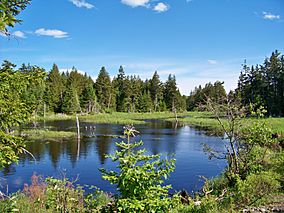Moosehorn National Wildlife Refuge facts for kids
Quick facts for kids Moosehorn National Wildlife Refuge |
|
|---|---|
|
IUCN Category IV (Habitat/Species Management Area)
|
|

Moosehorn National Wildlife Refuge
|
|
| Location | Washington County, Maine, United States |
| Nearest city | Calais, Maine |
| Area | 28,751 acres (116.35 km2) |
| Established | 1937 |
| Governing body | U.S. Fish and Wildlife Service |
| Website | Moosehorn National Wildlife Refuge |
Moosehorn National Wildlife Refuge is a special place in Maine, United States. It's one of the northernmost National Wildlife Refuges along the Atlantic Flyway. This "flyway" is like a superhighway in the sky for birds. It follows the eastern coast of North America.
The refuge is super important for many birds. It gives them safe places to find food and build their nests. You can find many types of birds here. These include waterfowl (like ducks), wading birds (like herons), shorebirds, and even birds of prey (like eagles).
Moosehorn National Wildlife Refuge has two main parts, called divisions. The Baring Division is about 20,016 acres (81.00 km2) big. It's located near Calais, Maine. The Edmunds Division is about 8,735-acre (35.35 km2). It's located between Dennysville and Whiting. This part of the refuge touches the ocean waters of Cobscook Bay. Both divisions have a National Wilderness Area. These are huge areas kept wild for future generations.
Did you know a long trail called the East Coast Greenway passes through the refuge? This trail connects Calais, Maine, all the way to Key West, Florida!
Contents
Exploring Moosehorn's Wild Habitats
The land at Moosehorn National Wildlife Refuge is very diverse. It has rolling hills and big rock formations. You can also find streams, lakes, bogs (wet, spongy ground), and marshes (wetlands).
Forests and Shorelines
The higher parts of the refuge have a northern hardwood forest. This forest is full of trees like aspen, maple, birch, spruce, and fir. You'll also see tall white pine trees scattered around. The Edmunds Division has several miles of rocky shoreline. Here, the ocean tides can go up and down by as much as 24 feet (7.3 m) twice a day!
This mix of habitats helps many different kinds of wildlife live and thrive here. The people who work at Moosehorn National Wildlife Refuge (NWR) manage the land. They make sure to protect important things like migratory birds, endangered species, and wetlands. By making the habitats better, they help wildlife grow strong on the refuge.
Amazing Animals of Moosehorn
Many animals call Moosehorn home. Some animals, like woodcock, black bears, ruffed grouse, lynx, beaver, red fox, river otter, gray fox, moose, bobcat, coyote, raccoon, mink, and deer, do best in young forests.
How Forests Help Wildlife Thrive
In the past, wildfires helped keep the forest young. Farming also kept some areas open. But today, wildfires don't happen as often. Also, there isn't as much farmland. So, the refuge staff uses special programs to manage the habitat. They do things like carefully cutting some trees and using controlled burns. This helps create clearings and young forests. These areas provide food and cover for many wildlife species. This management has helped increase the number of woodcock, grouse, bear, and moose!
Wilderness Areas: Nature Untouched
About one-third of the refuge is a special federal wilderness area. There are two Wilderness Areas, one in each division. They are part of the National Wilderness Preservation System. These areas are managed with a "hands-off" approach. This means they are left as wild as possible. You can't use engines or bikes here. Habitat management is kept to a minimum. This allows these areas to grow into old-growth forests naturally.
Birds of Prey and Songbirds
Bald eagles are often seen in both parts of the refuge. They hunt for fish in the streams, ponds, and watery areas. In recent years, up to three pairs of eagles have even built nests at Moosehorn NWR! You can often spot eagles around Magurrewock Marsh in the Baring Division. They are also seen along the shore of Dennys Bay in the Edmunds Division. Osprey also nest in some of the refuge marshes. Up to four pairs use special platforms along the Charlotte Road.
The woodlands of Moosehorn NWR are also home to many songbirds. This includes "neotropical migrants." These are birds that breed (have their babies) in North America. Then, they fly south to Mexico, the Caribbean, and Central and South America for the winter. In mid-May, the forest fills with the songs of migrating warblers. Twenty-six different kinds of these small birds nest at the refuge. You can also find northern forest birds here, like boreal chickadees and spruce grouse.


